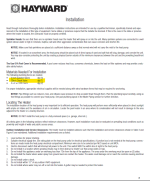My first post here was on the Introductory Forum this morning and I hope I’m not being obnoxious by posting a repeat in this forum, but I’m seeking some advice on how to proceed with installing a new heat pump heater.
Good morning. Here are our pool specs.
Installed in 2000
24,000 gallons
17’x37’ Mountain Lake by Cardinal Systems
Hayward 2 hp single speed Super Pump
Hayward 60 sq. ft. DE filter
Hayward in-line tab chlorinator
Polaris 380 cleaner
All 2” PVC piping (unfortunately flex underground)
After 23 seasons we want to install a heat pump heater to extend our pool enjoyment. Gas is not an option. When the pool was installed 24 years ago I had the installer leave valves so that I could install a heat exchanger that would be powered by my oil-fired boiler. Well, that never happened and now I don’t want to use my 100,00 Btu boiler for that purpose. ( I am a retired master plumber.)
The pumps are located about 45 feet from the pool and approximately 2 1/2 ft. above the pool surface.
We’re looking at a Hayward Heat Pro 140k heat pump and wonder :
-if the the pump elevation will be an issue
-the manual calls for a 1/3 check valve, what is that?
-would a variable speed pump be better suited to this new addition?
Thanks for any input you might have.
Peter
Good morning. Here are our pool specs.
Installed in 2000
24,000 gallons
17’x37’ Mountain Lake by Cardinal Systems
Hayward 2 hp single speed Super Pump
Hayward 60 sq. ft. DE filter
Hayward in-line tab chlorinator
Polaris 380 cleaner
All 2” PVC piping (unfortunately flex underground)
After 23 seasons we want to install a heat pump heater to extend our pool enjoyment. Gas is not an option. When the pool was installed 24 years ago I had the installer leave valves so that I could install a heat exchanger that would be powered by my oil-fired boiler. Well, that never happened and now I don’t want to use my 100,00 Btu boiler for that purpose. ( I am a retired master plumber.)
The pumps are located about 45 feet from the pool and approximately 2 1/2 ft. above the pool surface.
We’re looking at a Hayward Heat Pro 140k heat pump and wonder :
-if the the pump elevation will be an issue
-the manual calls for a 1/3 check valve, what is that?
-would a variable speed pump be better suited to this new addition?
Thanks for any input you might have.
Peter



